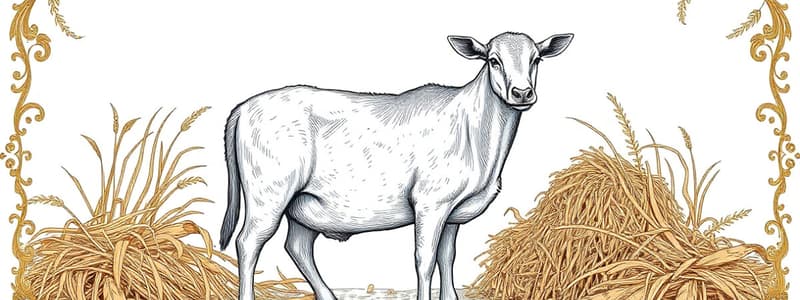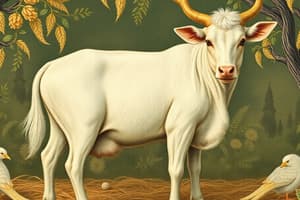Podcast
Questions and Answers
[Blank] silages are more difficult to ensile than corn silage due to their higher buffering capacity.
[Blank] silages are more difficult to ensile than corn silage due to their higher buffering capacity.
Legume
Ensiling forages under ______ conditions produces acids that preserve the feed, creating silage.
Ensiling forages under ______ conditions produces acids that preserve the feed, creating silage.
anaerobic
[Blank] meals are common plant protein supplements, valued for their high protein content in livestock diets.
[Blank] meals are common plant protein supplements, valued for their high protein content in livestock diets.
Soybean
The use of ______ in livestock diets is regulated due to concerns about antibiotic resistance.
The use of ______ in livestock diets is regulated due to concerns about antibiotic resistance.
[Blank], such as phytase, xylanase, and cellulase, are added to diets to improve the digestibility of certain feed components.
[Blank], such as phytase, xylanase, and cellulase, are added to diets to improve the digestibility of certain feed components.
[Blank] are used in ruminant diets to neutralize acids in the rumen and prevent acidosis.
[Blank] are used in ruminant diets to neutralize acids in the rumen and prevent acidosis.
Adding fats and oils to animal diets increases energy density and can also improve ______ and reduce dustiness.
Adding fats and oils to animal diets increases energy density and can also improve ______ and reduce dustiness.
[Blank] vitamins, like B vitamins and vitamin C, are not stored in the body, requiring daily supplementation.
[Blank] vitamins, like B vitamins and vitamin C, are not stored in the body, requiring daily supplementation.
[Blank] refers to the entire corn or sorghum plant harvested at maturity and dried.
[Blank] refers to the entire corn or sorghum plant harvested at maturity and dried.
[Blank] are live microorganisms added to diets to improve gut health and digestion, often used in diets for young animals.
[Blank] are live microorganisms added to diets to improve gut health and digestion, often used in diets for young animals.
Flashcards
Dry Roughages
Dry Roughages
Forages and roughages that are cut and dried for animal feed, including hay, straw, fodder, and stover.
Straw
Straw
Mature, dry stalks of grains after the seeds are harvested, primarily used as a fiber source due to low nutrient content..
Fodder
Fodder
The entire corn or sorghum plant harvested at maturity and dried, offering more nutrients than straw but less than hay.
Pasture
Pasture
Signup and view all the flashcards
Silage
Silage
Signup and view all the flashcards
Energy Feeds (Grains)
Energy Feeds (Grains)
Signup and view all the flashcards
Byproduct Feeds
Byproduct Feeds
Signup and view all the flashcards
Protein Supplements
Protein Supplements
Signup and view all the flashcards
Mineral Supplements
Mineral Supplements
Signup and view all the flashcards
Feed Additives
Feed Additives
Signup and view all the flashcards
Study Notes
- Feedstuffs are classified based on their origin, nutrient composition, and use in animal feeding
Dry roughages
- Includes all forages and roughages cut and cured
- Includes hay, straw, fodder, and stover
Hay
- Legume hays (alfalfa, clover) are higher in protein, energy, and calcium than grass hays (timothy, bromegrass)
- Quality is affected by maturity at harvest, harvesting and storage methods
Straw
- Straw is the mature, dry stalks of grains after the seeds have been harvested
- Low in nutrients and digestibility, primarily used as a source of fiber
Fodder
- Fodder refers to the entire corn or sorghum plant harvested at maturity and dried
- Provides more nutrients than straw but less than hay
Stover
- Stover is the mature corn or sorghum stalks and leaves remaining in the field after grain harvest
- Similar in nutritive value to straw
Pasture, range plants, and forages fed fresh
- Includes all forages harvested or grazed in a fresh state
Pasture
- Pasture is managed grassland or planted forages used for grazing
- Nutritive value varies with plant species, stage of maturity, and soil fertility
Range plants
- Range plants are native grasses, forbs, and shrubs grazed by livestock on rangelands
- Nutritive value varies greatly depending on plant species, season, and grazing management
Forages fed fresh
- Green chop is freshly cut forages that are fed to livestock
- Can provide high levels of nutrients if harvested at the proper stage of maturity
Silages
- Silage is produced by ensiling forages or other feedstuffs under anaerobic conditions
- Fermentation produces acids that preserve the feed
Corn silage
- Corn silage is a common feed for ruminants
- High in energy and relatively low in protein
Legume silage
- Legume silages (alfalfa, clover) can be high in protein and energy
- More difficult to ensile than corn silage due to higher buffering capacity
Grass silage
- Grass silages can be a good source of fiber and energy for ruminants
- Quality depends on the stage of maturity at harvest
Energy feeds
- Includes cereal grains, byproduct feeds, and fats
- High in energy and relatively low in fiber
Cereal grains
- Corn, barley, oats, wheat, and sorghum are commonly used as energy feeds
- Corn is the most common energy feed in the US due to its high energy content and availability
Byproduct feeds
- Byproduct feeds from the milling and processing industries
- Examples: wheat middlings, corn gluten feed, distillers grains
Fats
- Fats and oils are added to diets to increase energy density
- Can improve palatability and reduce dustiness
Protein supplements
- Includes plant and animal protein sources
- Contain high concentrations of protein
Plant protein sources
- Soybean meal is the most common plant protein supplement
- Other plant protein sources: cottonseed meal, canola meal, sunflower meal
Animal protein sources
- Animal protein sources: fish meal, meat and bone meal, dried milk products
- Used in diets for non-ruminants and young animals
Mineral supplements
- Provide essential minerals that may be deficient in basal diets
Macro-minerals
- Calcium, phosphorus, magnesium, potassium, sodium, chlorine, and sulfur
- Commonly supplemented in livestock diets
Trace minerals
- Iron, zinc, copper, manganese, iodine, selenium, and cobalt
- Often provided in trace mineral premixes
Vitamin supplements
- Provide essential vitamins that may be deficient in basal diets
Fat-soluble vitamins
- Vitamins A, D, E, and K
- Stored in the body, so toxicity can occur with excessive supplementation
Water-soluble vitamins
- B vitamins and vitamin C
- Not stored in the body, so daily supplementation is necessary
Additives
- Includes a variety of non-nutritive substances added to diets to improve performance, health, or feed quality
Antibiotics
- Used to improve growth rate and feed efficiency in livestock
- Use is regulated due to concerns about antibiotic resistance
Probiotics
- Live microorganisms that can improve gut health and digestion
- Often used in diets for young animals
Enzymes
- Added to diets to improve the digestibility of certain feed components
- Examples: phytase, xylanase, cellulase
Buffers
- Used to neutralize acids in the rumen and prevent acidosis
- Commonly used in diets for dairy cattle
Antioxidants
- Added to diets to prevent oxidation of fats and vitamins
- Examples: vitamin E, selenium, ethoxyquin
Hormones
- Used to improve growth rate and feed efficiency in livestock
- Use is regulated due to concerns about human health
Flavors
- Added to diets to improve palatability and feed intake
- Especially useful in diets for young animals or animals with reduced appetite
Studying That Suits You
Use AI to generate personalized quizzes and flashcards to suit your learning preferences.




